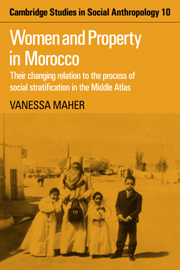 Women and Property in Morocco
Women and Property in Morocco Book contents
- Frontmatter
- Contents
- List of tables
- List of illustrations
- Preface
- Note on orthography
- Map of the Akhdar region
- Introduction
- 1 The background
- 2 Estates, tribal groups and the market today
- 3 Patron-client relations
- 4 How it looks on the ground
- 5 The cultural corollary: education and social stratification
- 6 Religion and social stratification
- 7 Conjugal roles, kinship roles and the division of labour
- 8 Relationships among women
- 9 Fostering
- 10 Marriage
- 11 Marriage and the market
- 12 The position of the bride after marriage
- 13 Divorce and property
- Conclusions
- Glossary
- Select bibliography
- Index
- Frontmatter
- Contents
- List of tables
- List of illustrations
- Preface
- Note on orthography
- Map of the Akhdar region
- Introduction
- 1 The background
- 2 Estates, tribal groups and the market today
- 3 Patron-client relations
- 4 How it looks on the ground
- 5 The cultural corollary: education and social stratification
- 6 Religion and social stratification
- 7 Conjugal roles, kinship roles and the division of labour
- 8 Relationships among women
- 9 Fostering
- 10 Marriage
- 11 Marriage and the market
- 12 The position of the bride after marriage
- 13 Divorce and property
- Conclusions
- Glossary
- Select bibliography
- Index
Summary
In this brief account of the geographical and historical background of Akhdar and its region, I wish to stress the pre-Protectorate opposition between the impersonal and centralised authority of the Makhzen, and the ‘egalitarian’, segmentary organisation of the tribes ‘outside the law’, which was modified by alliance strategies and by the chance economic disequilibrium, ground for petty tyrannies to germinate.
The town immediately before the Protectorate in a more thoroughgoing sense than today was the site of market relations and the state machine; the social structure of the rural Middle Atlas was barely affected by these institutions. Here, social life was organised according to the principle of ascribed status. French penetration extended the economic and political sway of the central authority over the countryside. It did little to abolish the structural antagonism between them. This factor goes some way towards accounting for the importance of status-based social relations in the Middle Atlas today.
Climate
The study was carried out in the anticline which separates the southern slopes of the Middle Atlas from the northern ones of the Central High Atlas.
Although it is high, at 1700 metres (5000 feet) Akhdar is reputed to escape the rigours of winter experienced by the mountains to the north and south, and the waterless barrenness of summer reported from the Tafilalet region to the south. However, in winter, the snow falls to a depth of two or three feet, and winds rage;
- Type
- Chapter
- Information
- Women and Property in MoroccoTheir Changing Relation to the Process of Social Stratification in the Middle Atlas, pp. 6 - 23Publisher: Cambridge University PressPrint publication year: 1975
